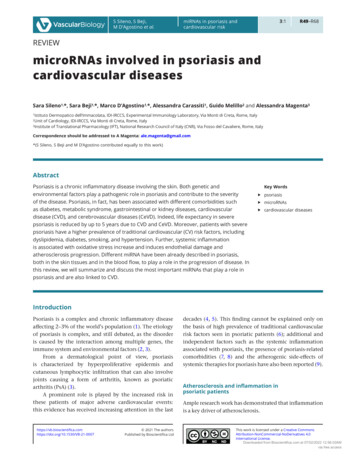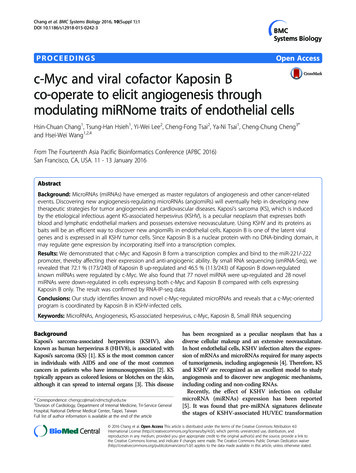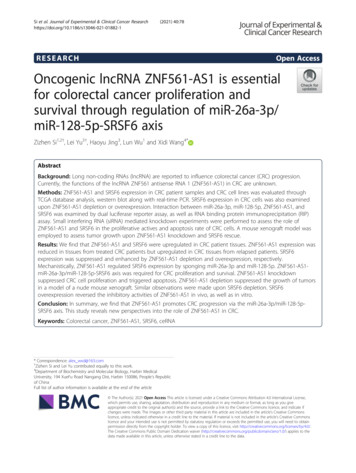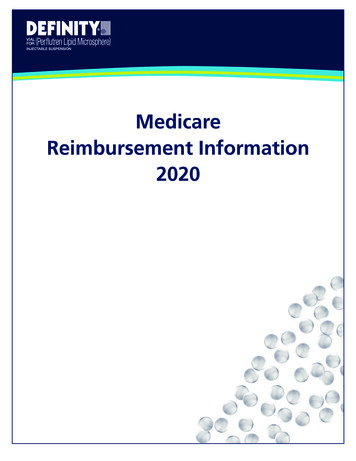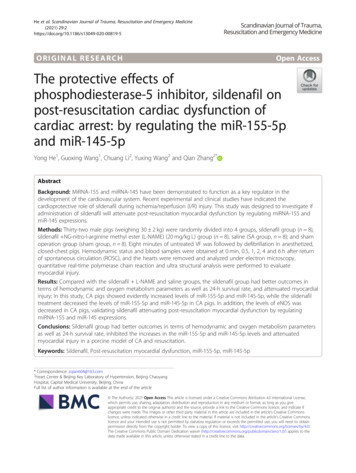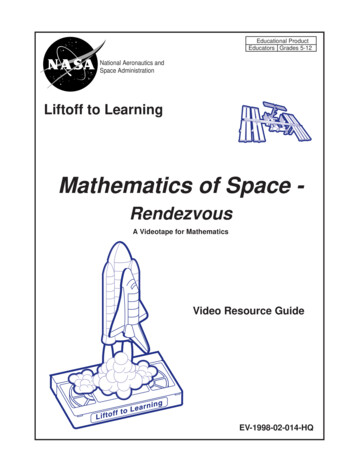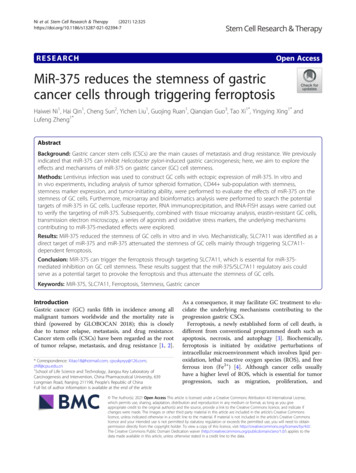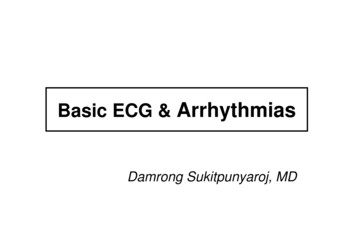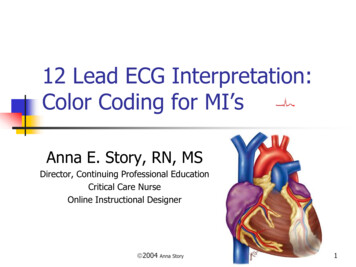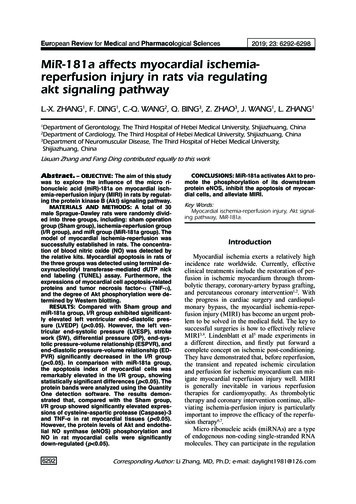
Transcription
European Review for Medical and Pharmacological Sciences2019; 23: 6292-6298MiR-181a affects myocardial ischemiareperfusion injury in rats via regulatingakt signaling pathwayL.-X. ZHANG1, F. DING1, C.-Q. WANG2, Q. BING3, Z. ZHAO3, J. WANG1, L. ZHANG1Department of Gerontology, The Third Hospital of Hebei Medical University, Shijiazhuang, ChinaDepartment of Cardiology, The Third Hospital of Hebei Medical University, Shijiazhuang, China3Department of Neuromuscular Disease, The Third Hospital of Hebei Medical University,Shijiazhuang, China12Lixuan Zhang and Fang Ding contributed equally to this workAbstract. – OBJECTIVE: The aim of this studywas to explore the influence of the micro ribonucleic acid (miR)-181a on myocardial ischemia-reperfusion injury (MIRI) in rats by regulating the protein kinase B (Akt) signaling pathway.MATERIALS AND METHODS: A total of 30male Sprague-Dawley rats were randomly divided into three groups, including: sham operationgroup (Sham group), ischemia-reperfusion group(I/R group), and miR group (MiR-181a group). Themodel of myocardial ischemia-reperfusion wassuccessfully established in rats. The concentration of blood nitric oxide (NO) was detected bythe relative kits. Myocardial apoptosis in rats ofthe three groups was detected using terminal deoxynucleotidyl transferase-mediated dUTP nickend labeling (TUNEL) assay. Furthermore, theexpressions of myocardial cell apoptosis-relatedproteins and tumor necrosis factor-α (TNF-α),and the degree of Akt phosphorylation were determined by Western blotting.RESULTS: Compared with Sham group andmiR-181a group, I/R group exhibited significantly elevated left ventricular end-diastolic pressure (LVEDP) (p 0.05). However, the left ventricular end-systolic pressure (LVESP), strokework (SW), differential pressure (DP), end-systolic pressure-volume relationship (ESPVR), andend-diastolic pressure-volume relationship (EDPVR) significantly decreased in the I/R group(p 0.05). In comparison with miR-181a group,the apoptosis index of myocardial cells wasremarkably elevated in the I/R group, showingstatistically significant differences (p 0.05). Theprotein bands were analyzed using the QuantityOne detection software. The results demonstrated that, compared with the Sham group,I/R group showed significantly elevated expressions of cysteine-aspartic protease (Caspase)-3and TNF-α in rat myocardial tissues (p 0.05).However, the protein levels of Akt and endothelial NO synthase (eNOS) phosphorylation andNO in rat myocardial cells were significantlydown-regulated (p 0.05).6292CONCLUSIONS: MiR-181a activates Akt to promote the phosphorylation of its downstreamprotein eNOS, inhibit the apoptosis of myocardial cells, and alleviate MIRI.Key Words:Myocardial ischemia-reperfusion injury, Akt signaling pathway, MiR-181a.IntroductionMyocardial ischemia exerts a relatively highincidence rate worldwide. Currently, effectiveclinical treatments include the restoration of perfusion in ischemic myocardium through thrombolytic therapy, coronary-artery bypass grafting,and percutaneous coronary intervention1,2. Withthe progress in cardiac surgery and cardiopulmonary bypass, the myocardial ischemia-reperfusion injury (MIRI) has become an urgent problem to be solved in the medical field. The key tosuccessful surgeries is how to effectively relieveMIRI3,4. Lindenblatt et al5 made experiments ina different direction, and firstly put forward acomplete concept on ischemic post-conditioning.They have demonstrated that, before reperfusion,the transient and repeated ischemic circulationand perfusion for ischemic myocardium can mitigate myocardial reperfusion injury well. MIRIis generally inevitable in various reperfusiontherapies for cardiomyopathy. As thrombolytictherapy and coronary intervention continue, alleviating ischemia-perfusion injury is particularlyimportant to improve the efficacy of the reperfusion therapy6,7.Micro ribonucleic acids (miRNAs) are a typeof endogenous non-coding single-stranded RNAmolecules. They can participate in the regulationCorresponding Author: Li Zhang, MD, Ph.D; e-mail: daylight1981@126.com
MiR-181a in myocardial ischemia-reperfusion injuryof post-transcriptional gene expression in animals and plants8. So far, multiple miRNAs havebeen confirmed to exist in plants, animals, andviruses. MiR-181a is a miRNA located on human chromosome 1q32.1. Previous scholars havefocused on its role in cancers. Multiple studieshave demonstrated that miR-181a is related tothe sensitivity of cancer cells to chemotherapydrugs9. Meanwhile, it can directly act on targetgenes and comprehensively regulate the migration, invasion, proliferation, and apoptosis ofcancer cells10,11. Byrne et al12 have reported thatmiRNAs are closely related to the protein kinaseB (Akt) signaling pathway in the treatment ofmyocardial ischemia. Additionally, relevant researches13 have suggested that the Akt pathwayregulates the majority of responses in mammal cells. Furthermore, in ischemia-perfusion(I/R), the activation of the Akt signaling pathwaycan repress cell apoptosis and activate survivalpathways. However, whether miR-181a protectsagainst ischemia-perfusion injury via the Aktpathway remains unknown. Therefore, the aim ofthis work was to explore the role of miR-181a inmyocardial ischemia-reperfusion injury (MIRI)in rats by regulating the protein kinase B (Akt)signaling pathway.Materials and MethodsExperimental Materials and GroupingA total of 30 male Sprague-Dawley (SD) ratsweighing 0.24-0.26 kg and aged about 7 weeksold were provided by the Animal Core Facilityof Jinzhou Medical University. All rats were fedwith humidity of 38-50% and temperature of 2125 C. This study was approved by the AnimalEthics Committee of Hebei Medical UniversityAnimal Center. All SD rats were randomly divided into 3 groups (with 10 rats in each group),including: sham operation group (Sham group),ischemia-reperfusion group (I/R group), and miRgroup (MiR-181a group). For Sham group: duringsurgery, threading was required without ligation.Meanwhile, 2 mL of normal saline was injectedinto the abdominal cavity 1 min before the surgery. For I/R group: after 1 h of ligation, reperfusion lasted for 2 h. 10 min before surgery, 2 mLof normal saline was injected into the abdominalcavity. For MiR-181a group: after 1 min of ligation, the reperfusion was conducted for 2 h. 10min before surgery, 5 mg/kg miR-181a was injected into the abdominal cavity in a bolus manner.Experimental Instrumentsand ReagentsRabbit polyclonal antibodies for cysteine-aspartic protease (Caspase)-3, tumor necrosis factor-α (TNF-α), and phosphorylated protein kinaseB (Akt) were purchased from Abcam (Cambridge,MA, USA); terminal deoxynucleotidyl transferase-mediated dUTP nick end labeling (TUNEL)assay kit, 1.9 F volumetric catheter from ScienceInstruments (East Oshawa, ON, Canada) and nitric oxide (NO) detection kit from Roche (Roche,Basel, Switzerland).Establishment of MyocardialReperfusion Model in RatsThe myocardial reperfusion model was firstestablished in rats according to the followingprocedure. After anesthesia with an injectionof 3% pentobarbital sodium anesthetic into theabdomen, the rats were fixed on an operatingtable. The trachea was cut open and connectedwith a respirator to maintain them breathing13. Acannula accessed to the left ventricle through theright carotid artery to collect the cardiac function-related parameters. A longitudinal incisionwas first made at the left sternal margin, withthe strongest cardiac apex beat. Subsequently, thesubcutaneous tissues were separated using a blunttool, and the thoracic cavity was cut open to expose the heart. Next, the pulmonary conus fromleft to right was raised using tweezers. Taken asa reference with the left coronary artery, theywere sutured together with a silicone tube at 1.5mm away from the left edge of the auricle. Additionally, to ensure that there was no blood flowwithin 1 h of coronary artery ligation, perfusionwas continued for 2 h after the release of ligation.Finally, a MIRI model was surgically establishedin the rats. After ligation, the electrocardiogramshowed ST segment elevated by over 0.1 mVand enlarged amplitude of QRS waves, withgreyish white myocardium. These characteristicsindicated successful blocking. After successfulmodeling, the cardiac function parameters werecollected, and 1 mL of the blood sample was extracted from the carotid artery. Post-operatively,once rats in all groups were executed, the heartwas immediately removed14.Cardiac FunctionAfter successful modeling, the cardiac functionparameters, including end-systolic pressure-volume relationship (ESPVR), left ventricular end-systolic pressure (LVESP), differential pressure (DP),6293
L.-X. Zhang, F. Ding, C.-Q. Wang, Q. Bing, Z. Zhao, J. Wang, L. Zhangstroke work (SW) and left ventricular end-diastolic pressure (LVEDP) were measured instantly.Meanwhile, the end-diastolic pressure-volume relationship (EDPVR) was recorded and calculatedwith a pressure volume catheter.Detection of Myocardial CellApoptosis Via TUNEL AssayThe tissue proteins were first removed using proteinase K working solution. Subsequently,the tissues in each group were added with thecorresponding concentration of TUNEL assaysolution and 50 mL of TUNEL reaction mixture.After drying the glass, they were incubated at37 C for 1 h in the dark. The products were thenwashed with Phosphate-Buffered Saline (PBS)for 3 times, and the number of apoptotic cellswas counted under a microscope. After that,the tissues were added with 50 mL of TUNELreaction mixture and incubated for other 0.5 has above. After rinsing for 3 times, 50-100 mLof diaminobenzidine (DAB) substrates (Solarbio,Beijing, China) were added, followed by 12-20min of reaction. Finally, the products were rinsedfor 3 times for detection.Protein Expression of Caspase-3,Akt Phosphorylation and TNF-αVia Western BlottingAfter reperfusion, the heart of rats in eachgroup was excised. The myocardial tissues werethen lysed to extract the total protein on ice.The concentration of proteins was measuredusing the bicinchoninic acid (BCA) method(Pierce, Rockford, IL, USA). Subsequently, 100g of myocardial tissue proteins were separatedby 12% dodecyl sulfate and sodium salt-polyacrylamide gel electrophoresis (SDS-PAGE)and transferred onto polyvinylidene difluoridemembranes. After sealing with 5% skim milk,the membranes were incubated with primary antibodies [Akt, endothelial NO synthase(p-eNOS), NOS, Caspase-3, phosphorylated-Akt(p-Akt), and TNF-α] overnight. On the nextday, the membranes were washed with TBSTfor 3 times and incubated with horseradishperoxidase (HRP)-labeled secondary antibodies(diluted at 1:5000) at room temperature for 2 h.The color development reaction was performedby enhanced chemiluminescence (ECL) method.Finally, the brightness value of the bands in eachgroup was analyzed and calculated via QuantityOne imaging analyzer.Determination of NOAfter reperfusion, 1 mL of blood was collected from the carotid artery of rats in each group.After centrifugation at 4 C, the supernatant wasobtained. The content of NO in each group wasdetermined according to the instructions of therelevant kit (Abcam, Cambridge, MA, USA).Statistical AnalysisThe Statistical Product and Service Solutions(SPSS) 18.0 (SPSS Inc., Chicago, IL, USA) software was used for all statistical analyses. TheDunnett’s test was adopted for paired comparisons, and the F-test was employed for inter-groupmean comparisons. The data were tested forhomogeneity of variance and normal distribution.p 0.05 was considered statistically significant.ResultsCardiac FunctionCompared with the Sham group and MiR-181agroup, I/R group exhibited significantly lowerEDPVR, SW, DP, ESPVR, and LVESP (p 0.05).However, LVEDP was remarkably elevated in theI/R group (p 0.05) (Table I).Table I. Comparisons of rat cardiac function parameters among all the groups.LVEDP (mmHg)DP (mmHg)ESPVR (mmHg/μL)LVESP (mmHg)SW (mmHg/μL)EDPVR (mmHg/μL)Sham group(n 10)I/R group(n 10)MiR-181a group(n 10)F7.3 1.0103 3.21.35 0.17110.5 2.59372 5340.016 0.003815.6 1.7*54.6 4.0*0.98 0.11*71.1 3.9*4712 128*0.0016 0.0006*10.5 0.8#74.8 3.7#1.24 0.13#85.0 3.2#6758.0 296#0.0064 0.0012#96.7187.126.5172.4109.298.5Note: *p 0.05, vs. Sham group and #p 0.05, vs. I/R group.6294p 0.001 0.001 0.001 0.001 0.001 0.001
MiR-181a in myocardial ischemia-reperfusion injuryFigure 1. Myocardial cell apoptosis detected by TUNEL staining among all the three groups (magnification 40).Myocardial Cell ApoptosisAccording to the TUNEL staining results, thenormal rat myocardial cells were blue, while thenucleus of the necrotic or apoptotic positive cellswas tan (Figure 1). The myocardial cell apoptosisindex in the I/R group and MiR-181a group was29.8-46.8% and 19.8-41.9%, respectively. Thedifference was statistically significant betweenthe two groups (p 0.05).Protein Expressions of Caspase-3and TNF-α in Rat Myocardiumof Each GroupCompared with the Sham group, the proteinexpressions of Caspase-3 and TNF-α in myocardial tissues were significantly in I/R group (by 4.6times and 4.9 times, respectively), with significantdifferences (p 0.05). However, they were remark-ably down-regulated in MiR-181a group whencompared with the I/R group (p 0.05) (Figure 3).Levels of Akt, NO, and p-eNOSin Rats of Each GroupCompared with the Sham group, the levels of NO,Akt, and p-eNOS were significantly down-regulatedin the rat myocardial cells of the I/R group, showingstatistically significant differences (p 0.05). However, the above indexes were remarkably elevated inboth MiR-181a and I/R group (p 0.05). The levelsof NO and p-eNOS in myocardial cells in MiR-181agroup were substantially higher than those in theSham group, and the differences were statisticallysignificant (p 0.05). However, no significant difference was observed in the relative expression level ofAkt (p 0.05) (Figures 4 and 5).DiscussionCurrently, cardiac surgery and cardiopulmonary bypass are very common in clinicalpractice. However, after myocardial reperfusion,these patients may suffer from a series of complications such as arrhythmia, severe contraction,Figure 2. Myocardial cell apoptosis detected via TUNELstaining assay. Note: *p 0.05, vs. Sham group and #p 0.05,vs. I/R group.Figure 3. Expressions of Caspase-3 and TNF-α in rat myocardial cells in the rats of all groups.6295
L.-X. Zhang, F. Ding, C.-Q. Wang, Q. Bing, Z. Zhao, J. Wang, L. ZhangFigure 4. Protein expressions of Akt, NO, and p-eNOS inthe rats of all groups.and diastolic dysfunction, namely MIRIs14. As acommon clinical complication, I/R causes myocardial cell apoptosis and destroys the normalstructure of myocardial tissues. Meanwhile, italso gives rise to decreased cardiac function ormortal arrhythmia15,16. According to the resultsof this study, compared with the Sham groupand MiR-181a group, the I/R group showed significantly elevated LVEDP, as well as reducedLVESP, SW, DP, ESPVR, and EDPVR (p 0.05).Moreover, myocardial cell apoptosis index in theI/R group and MiR-181a group was 29.8-46.8%and 19.8-41.9%, respectively. The difference wasstatistically significant between the two groups(p 0.05). Lu et al17 have found that miR-181areduces oxidative stress to alleviate I/R injury.Li et al18 have demonstrated that miR-181a canprotect the myocardium and inhibit the formationof free radicals, thereby repressing the apoptosisof myocardial cells. These results were similarABto the findings of the present study, namely miR181a protected the myocardium by inhibiting theapoptosis of myocardial cells.In this research, the administration with miR181a could significantly relieve MIRI at the earlystage of myocardial reperfusion. However, ourresults showed that the I/R group had significantly elevated expression levels of TNF-α andCaspase-3. This verified that MIRI was closelyrelated to the activation of apoptosis pathways.In cardiovascular diseases, miRNAs can regulate target genes, thereby playing importantroles in myocardial hypertrophy, necrosis, andapoptosis. They can also participate in each onset of AMI. Since miRNAs keep stable in bloodand exhibit remarkably differential expressionsunder various physiological and pathologicalconditions, they are considered as ideal biomarkers in blood tests for diseases. Bostjancicet al19 have pointed out that plasma miR-1,miR-208, and miR-499 serve as underlying biomarkers for predicting AMI. Ke et al20 havefound that in I/R, there are two major signalingpathways related to myocardial cell apoptosis.The first is the intrinsic pathway that mitochondria activate Caspase-3 to induce apoptosis.The second one is the external pathway of Fasligand or TNF-α. Zhou et al21 have shown thatCaspase-3 and TNF-α are closely correlatedwith myocardial ischemia. Meanwhile, in I/R,miR-181a suppresses the protein expressions ofCaspase-3 and TNF-α in myocardial apoptosis-related pathways. In the present study, theprotein expressions of Caspase-3 and TNF-αwere the highest in the I/R group. Their proteinexpressions decreased after treatment with miR181a, suggesting that miR-181a could inhibitboth Caspase-3 and TNF-α in the myocardium.CFigure 5. A-C, Levels of Akt, NO, and p-eNOS in myocardial cells of each group determined via Western blotting. Note:*p 0.05, vs. I/R group and #p 0.05, vs. MiR-181a group.6296
MiR-181a in myocardial ischemia-reperfusion injuryCompared with the Sham group, the I/R groupexhibited significantly decreased levels of NO, Akt,and p-eNOS in rat myocardial cells, and the differences were statistically significant (p 0.05). Moreover, these levels significantly increased in bothMiR-181a and I/R group (p 0.05). The levels ofNO and p-eNOS in MiR-181a group were remarkably up-regulated when compared with those inthe Sham group (p 0.05). These findings provedthat miR-181a could inhibit myocardial apoptosisby activating the Akt signaling pathway, so as toprotect from MIRI. Currently, the role of the Aktsignaling pathway in myocardial I/R has been aresearch hotspot. It has been found that the inhibition of Akt signals by P13K/Akt inhibitor canaccelerate the apoptosis of myocardial cells22,23. Thephosphorylation of Akt promotes the activation ofvarious target proteins, including p-eNOS24. Suchalet al25 have suggested that the phosphorylation ofAkt also mediates the quick response of p-eNOSto stress in vivo or in vitro. Activated p-eNOS playsan important role in I/R. The present experimentstarted with the Akt signaling pathway to corroborate the influence of miR-181a on I/R injury. It wasdiscovered that in I/R, miR-181a phosphorylatedAkt and promoted the phosphorylation of p-eNOSas well. However, the expression of p-eNOS couldup-regulate the concentration of endothelium-derived vascular relaxing factor NO in blood, whichregulated the growth, apoptosis, and migration ofvascular endothelial cells. Ultimately, this inhibitedthe apoptosis of myocardial cells.ConclusionsWe found that the activation of Akt by miR181a accelerates the phosphorylation of its downstream protein p-eNOS, represses myocardial cellapoptosis, and mitigates MIRI.Conflict of InterestsThe authors declare that they have no conflict of interests.References1) Singh AK. Percutaneous coronary intervention vscoronary artery bypass grafting in the management of chronic stable angina: a critical appraisal.J Cardiovasc Dis Res 2010; 1: 54-58.2) Pan YQ, L i J, L i XW, L i YC, L i J, L in JF. Effect of miR21/TLR4/NF-κB pathway on myocardial apoptosis in rats with myocardial ischemia-reperfusion.Eur Rev Med Pharmacol Sci 2018; 22: 7928-7937.3) Shernan SK. Perioperative myocardial ischemiareperfusion injury. Anesthesiol Clin North Am2003; 21: 465-485.4) Orhan G, Yapici N, Yuksel M, Sargin M, Senay S,Yalcin AS, Aykac Z, A ka SA. Effects of N-acetylcysteine on myocardial ischemia-reperfusion injuryin bypass surgery. Heart Vessels 2006; 21: 42-47.5) L indenblatt N, Schareck W, Belusa L, Nickels RM,Menger MD, Vollmar B. Anti-oxidant ebselen delays microvascular thrombus formation in the ratcremaster muscle by inhibiting platelet P-selectinexpression. Thromb Haemost 2003; 90: 882-892.6) Zhang YJ, Wang JN, Tang JM, Huang YZ, YangJY, Guo LY. [Protective effect of preconditioningwith PEP-1-CAT fusion protein against myocardialischemia-reperfusion injury in rats]. Nan Fang YiKe Da Xue Xue Bao 2009; 29: 2429-2432.7) Werns SW, Lucchesi BR. Myocardial ischemia andreperfusion: the role of oxygen radicals in tissueinjury. Cardiovasc Drugs Ther 1989; 2: 761-769.8) Ye Y, Perez-Polo JR, Qian J, Birnbaum Y. Therole of microRNA in modulating myocardial ischemia-reperfusion injury. Physiol Genomics 2011;43: 534-542.9) Slaby O, L akomy R, Fadrus P, Hrstka R, K ren L,L zicarova E, Smrcka M, Svoboda M, Dolezalova H,Novakova J, Valik D, Vyzula R, Michalek J. MicroRNA-181 family predicts response to concomitantchemoradiotherapy with temozolomide in glioblastoma patients. Neoplasma 2010; 57: 264-269.10) Xu H, Zhu J, Hu C, Song H, Li Y. Inhibition ofmicroRNA-181a may suppress proliferation andinvasion and promote apoptosis of cervical cancer cells through the PTEN/Akt/FOXO1 pathway.J Physiol Biochem 2016; 72: 721-732.11) L in Y, Zhao J, Wang H, C ao J, Nie Y. MiR-181amodulates proliferation, migration and autophagyin AGS gastric cancer cells and downregulatesMTMR3. Mol Med Rep 2017; 15: 2451-2456.12) Byrne NJ, L evasseur J, Sung MM, M asson G, Boisvenue J, Young ME, D yck JR. Normalization ofcardiac substrate utilization and left ventricularhypertrophy precede functional recovery in heartfailure regression. Cardiovasc Res 2016; 110:249-257.13) Xu MC, Shi HM, G ao XF, Wang H. Salidroside attenuates myocardial ischemia-reperfusion injuryvia PI3K/Akt signaling pathway. J Asian Nat ProdRes 2013; 15: 244-252.14) Moleerergpoom W, K anjanavanit R, Jintapakorn W,Sritara P. Costs of payment in Thai acute coronarysyndrome patients. J Med Assoc Thai 2007; 90Suppl 1: 21-31.15) Surinkaew S, Kumphune S, Chattipakorn S, Chattipakorn N. Inhibition of p38 MAPK during ischemia,but not reperfusion, effectively attenuates fatalarrhythmia in ischemia/reperfusion heart. J Cardiovasc Pharmacol 2013; 61: 133-141.16) L iu X, Zhang C, Qian L, Zhang C, Wu K, Yang C,Yan D, Wu X, Shi J. NF45 inhibits cardiomyocyteapoptosis following myocardial ischemia-reperfusion injury. Pathol Res Pract 2015; 211: 955-962.17) Lu YZ, Wang J, Song J, Zhang CY, Ji JQ, L i BH, TianXX, Song XL. [Effect of ischemic postconditioningon the expression of myocardium matrix metallo-6297
L.-X. Zhang, F. Ding, C.-Q. Wang, Q. Bing, Z. Zhao, J. Wang, L. Zhang18)19)20)21)proteinase-2 induced by ischemia/reperfusion inrats]. Zhongguo Ying Yong Sheng Li Xue Za Zhi2014; 30: 81-84.Li AL, Lv JB, Gao L. MiR-181a mediates Ang II-inducedmyocardial hypertrophy by mediating autophagy. EurRev Med Pharmacol Sci 2017; 21: 5462-5470.Bostjancic E, Zidar N, Stajer D, Glavac D. MicroRNAs miR-1, miR-133a, miR-133b and miR-208are dysregulated in human myocardial infarction.Cardiology 2010; 115: 163-169.Ke JJ, Yu FX, Rao Y, Wang YL. Adenosine postconditioning protects against myocardial ischemia-reperfusion injury though modulate production of TNF-αand prevents activation of transcription factorNF-kappaB. Mol Biol Rep 2011; 38: 531-538.Zhou T, Guo S, Wang S, L i Q, Zhang M. Protective effect of sevoflurane on myocardial ischemia-reperfusion injury in rat hearts and its impact on HIF-1α and caspase-3 expression. ExpTher Med 2017; 14: 4307-4311.629822) Zhang J, L iu XB, Cheng C, Xu DL, Lu QH, Ji XP.Rho-kinase inhibition is involved in the activationof PI3-kinase/Akt during ischemic-preconditioning-induced cardiomyocyte apoptosis. Int J ClinExp Med 2014; 7: 4107-4114.23) Jie B, Zhang X, Wu X, Xin Y, L iu Y, Guo Y. Neuregulin-1 suppresses cardiomyocyte apoptosis byactivating PI3K/Akt and inhibiting mitochondrialpermeability transition pore. Mol Cell Biochem2012; 370: 35-43.24) Bharti S, Golechha M, Kumari S, Siddiqui KM,A rya DS. Akt/GSK-3beta/eNOS phosphorylationarbitrates safranal-induced myocardial protectionagainst ischemia-reperfusion injury in rats. Eur JNutr 2012; 51: 719-727.25) Suchal K, Bhatia J, M alik S, M alhotra RK, G amadN, Goyal S, Nag TC, A rya DS, Ojha S. Seabuckthorn pulp oil protects against myocardial ischemia-reperfusion injury in rats through Activationof Akt/eNOS. Front Pharmacol 2016; 7: 155.
of endogenous non-coding single-stranded RNA molecules. They can participate in the regulation European Review for Medical and Pharmacological Sciences 2019; 23: 6292-6298 L.-X. ZHANG1, F. DING1, C.-Q. WANG2, Q. BING3, Z. ZHAO3, J. WANG1, L. ZHANG1 1Department of Gerontology, The Third Hospital of Hebei Medical University, Shijiazhuang, China
